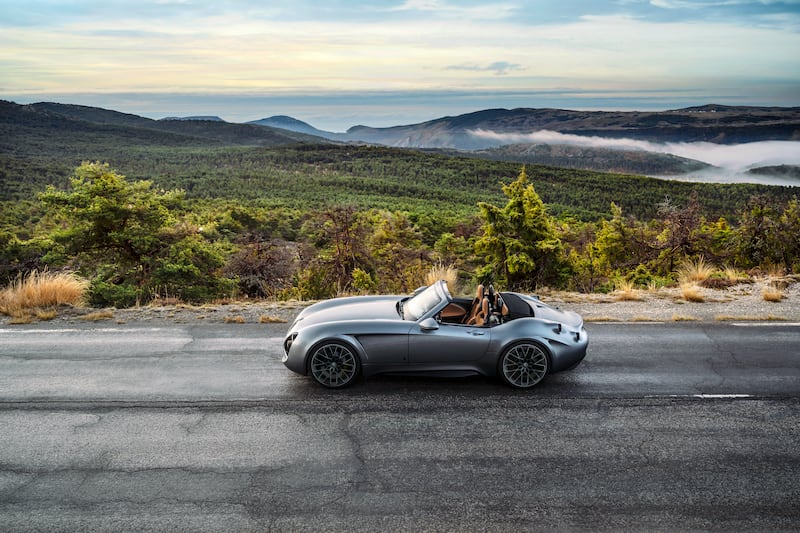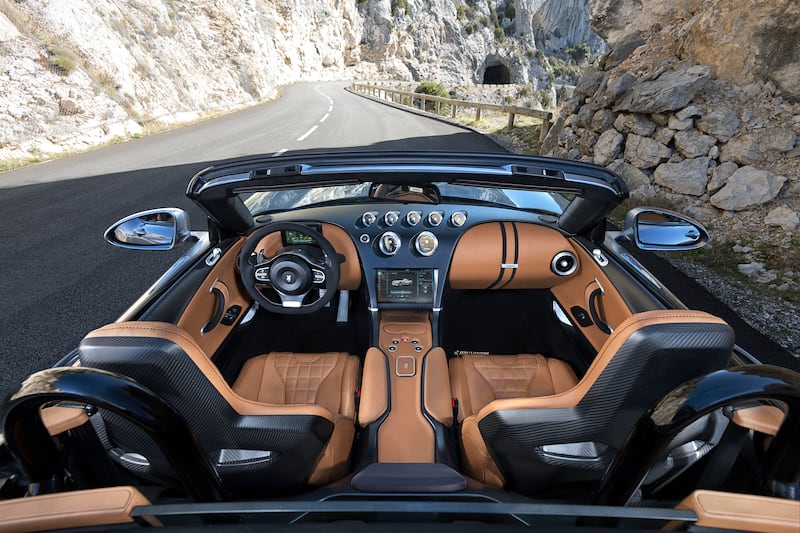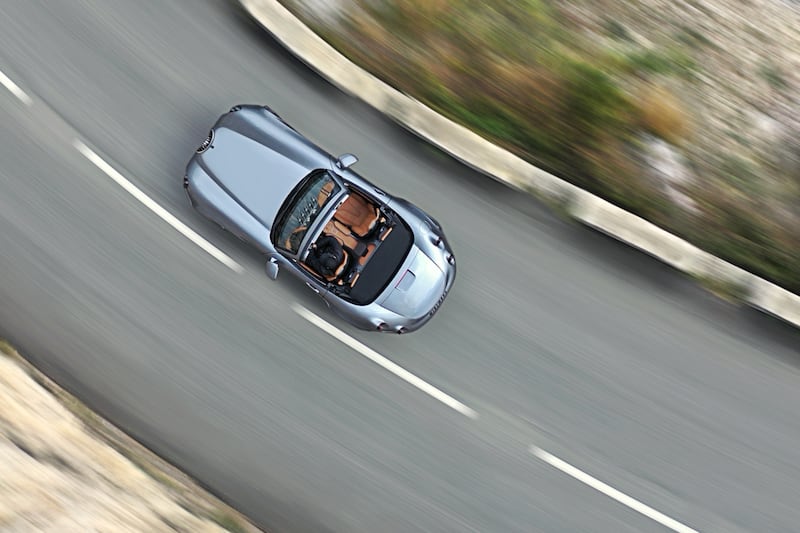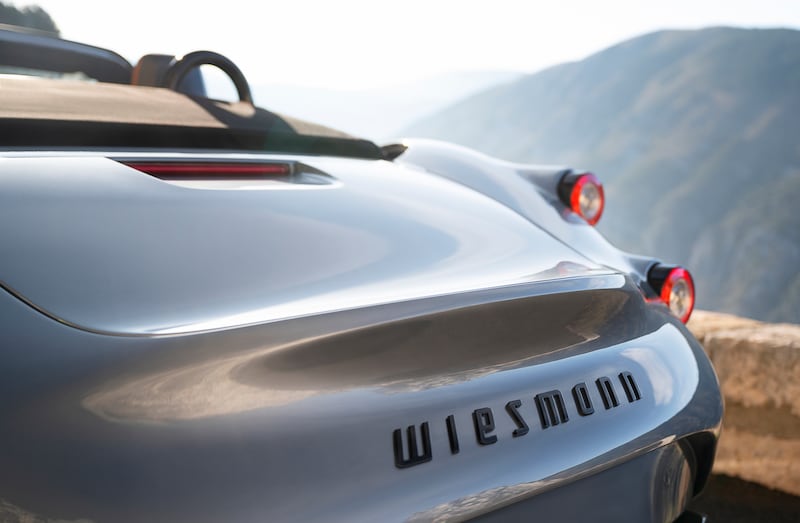Germany is a place of ordered rationality. This seems a point proven by our journey to Wiesmann’s HQ. To get here, we sit into a rational, upright, plain black Mercedes and are driven along straight, spotless Autobahns full of orderly, conscientious drivers. Rolling at careful, legal speeds through the town of Dülmen, we are surrounded by neat houses with neater lawns. We pass schools with perfectly tended buildings and tidy playgrounds. On the outskirts of the town are business parks with grids of rectilinear roads and buildings designed with set squares, not protractors.
And then … And then it all goes a bit hazy and dreamlike. Germany may be the country of ordered rationality, but it’s also the country that gave us the imagination of Goethe and legends of Grimm. Turning a corner, we’ve arrived at Wiesmann’s factory, and instead of the expected square-topped factory unit the roof is a riot of aluminium tubes, like the chassis of a 1960s sports car, welded and bent into the shape of a Gecko lizard. The Gecko is Wiesmann’s badge, perfectly representing the company’s cars’ ethos of being compact, light, grippy, and agile.
Sitting in front of the factory is something that — like Germany — looks familiar but which is actually bursting with insane creativity. The template for the Wiesmann family of roadsters was laid down by the eponymous brothers, Martin and Friedhelm, in 1988. Together, they designed a two-seat sports car, making the original aluminium spaceframe chassis in the basement of a relative’s house — and then had to disassemble part of the house to get the completed chassis out.
The body for that first MF30 sports car was a mixture of classic 1960s British and American sports car cues, with a small-slatted grille that seemed to reference Jaguar’s classic 1950s Le Mans C-Type race cars. Kept deliberately small, that first MF30 had a mere 231hp from a bought-in BMW straight-six engine.
RM Block
Wiesmann evolved fast, and BMW liked what the brothers were doing, allowing the company to use ever bigger and faster engines, which culminated in the mighty 5.0-litre M5 V10 engine being fitted to later MF5 models, before it in turn was replaced by the current M5′s 625hp twin-turbo V8 engine.
The car that sits in the surprisingly warm November sunlight in front of Wiesmann’s factory does not have a BMW V8. This is Project Thunderball, and it’s the brainchild of Roheen Berry, Wiesmann’s chief executive since he bought the company out of liquidation in 2017.

Berry is English-born, and of Indian stock, but has Irish grandparents and spent many childhood summers with relatives in Kinsale. He made his fortune in providing identity and security systems for border agencies around the world, and now he wants Wiesmann to take on that same world. But he’s not going to follow the standard small sports car playbook of creating a hot-rod body with a big, loud, petrol engine. Wiesmann’s going electric.
Project Thunderball uses the same aluminium chassis as the V8-engined cars, but strips out the combustion bits and instead inserts a bespoke T-shaped battery pack, made for Wiesmann by Roding Mobility, based in Munich. It’s a big battery, packing 83kWh of useable power and giving the Thunderball a potential range of up to 500km, with ultra-fast 300kW charging capability. Astonishingly, given the heft of a battery like that, the Thunderball weighs just 1,775kg thanks in part to an all-carbon-fibre body.

More importantly, that big battery gives the Thunderball power. Lots of power. 680hp, to be exact, and a frankly stupid 1,100Nm of torque thanks to two electric motors powering the rear wheels through a racing-spec Hewland gearbox. Go Harry Flatters on the throttle pedal and this low, muscular, deeply sexy car will fling you to 100km/h in just 2.9secs.
In theory. I say in theory because this Project Thunderball is not a finished car. It looks finished — the paint on that carbon body is lustrous, as is the carbon-fibre dashboard and the seats which have the rich tan colour of a serial sunbather. However, this is a prototype, and the only one in existence. The Wiesmann and Roding guys have taken the decision to make sure that the car is safe to to work on, so the battery is detuned from its full potency, and is delivering a mere 437hp to the rear wheels today.
That seems sufficient when you climb aboard. The cockpit follows the layout of the older MF models (a badge that will be unsurprisingly dropped now that Wiesmann intends to sell cars in America — think Samuel L Jackson and you’ll understand why) with huge bank of analogue dials tilted towards the driver. You get digital screens, both behind the wheel and in the centre of the dash, but the dials look classy and elegant, and it’s an anachronistic joy to see battery charge and temperature rendered on a classic clock face. There’s noticeably more width in the cockpit than in the older V8 cars we’ve been driving in convoy, too so this Thunderball is going to be far more comfortable when you’re pushing that one-charge range to its limits.

What it’s not is slow. Even in this detuned form, the Thunderball bursts forward. It doesn’t have that kicked-down-a-lift-shaft effect of some EVs, which throw all their power (torque, actually) at you straight away and which can frankly make you feel a bit nauseous in doing so. In its current trim, the Thunderball feeds in the power progressively, but relentlessly — just like the V8s sitting next to it. By any standards, it’s quick but the surprising thing about this car — a prototype, remember, and not a finished car, is just how together it all feels. The steering is quick, light, and brimming with feel and information. The suspension is firm, but well-controlled and just a few tweaks shy of final production readiness. The whole structure feels incredibly solid and stiff, with not a single rattle nor squeak in the cabin.
All of which adds up to one thing — confidence. The Thunderball will retail for about €300,000 before taxes when it goes into production, but this one is still unique, and therefore effectively priceless. Yet within seconds, I have the confidence to fling it around and I’m soon wishing that our convoy leader — driving an MF5 with a twin-turbo V8 engine remember — would hurry up a bit as he’s holding me up. This is big, proper fun and all soundtracked by an eerie whooshing howl as you accelerate, as if the car is powered by the jet engine of the gods. It’s an intoxicating mix.
Let’s come back down to Earth for a moment, then. Wiesmann is a household name in Germany (literally — it’s the fifth-best-known carmaker in a recent poll) but outside of Germany it barely registers. It’s a tiny company, making a few hundred cars a year, and in the coming years it’s going to be facing all-electric rivals from Maserati, Porsche, Alpine, Lotus, and of course Tesla. It is a minnow amid sharks.
Or maybe it’s a Gecko amid snakes, but I wouldn’t underestimate Wiesmann either way. This is a company that won the respect of BMW and was almost bought by Chinese giant Geely before Berry snapped it up. It has a robust fanbase in Germany and has been making waves in America recently, where dealers are being signed up. There may even be right-hand drive production (Berry says the parts for that are in the warehouse).
Can it work? Can a tiny German carmaker, with a lizard for a badge, take on the manufacturing might of the global carmaking elite? Well, stranger things have happened in Germany. Just ask the Brothers Grimm.















